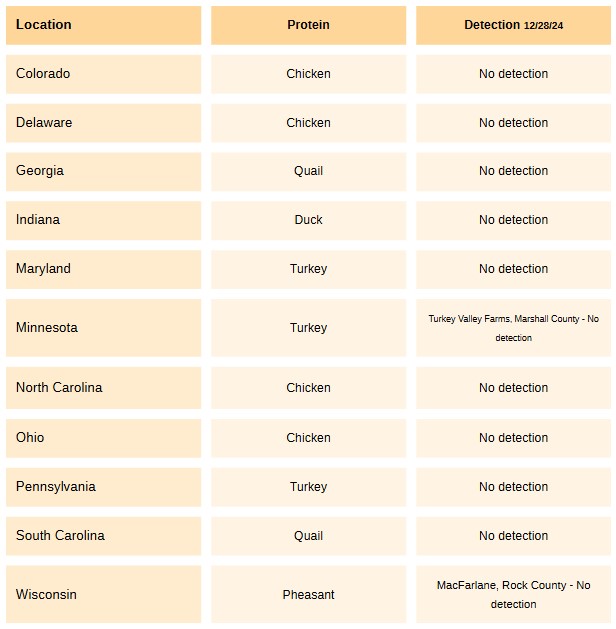Pet Health Awareness | Avian (Bird) Flu: HPAI H5N1 virus
Published on May 4, 2022
10/17/2025
Pet Health Awareness
Protect your pets from bird flu by observing symptoms and practicing prevention.
Takeaways:
- Bird flu usually appears in the spring and autumn.
- Animal symptoms often mirror those in humans, including fever, cough, runny nose, and fatigue.
- In most cases, animal flu is mild and generally resolves on its own without medical intervention.
- The flu has been successfully managed in both humans and animals for many years.
- A well-balanced diet, including species-appropriate antiviral foods, helps strengthen the immune system.
- The immune system serves as the body's primary defense against viruses and pathogens.
Recognizing Symptoms
Bird flu outbreaks often align with the migratory seasons of wild birds, particularly during spring and fall and can affect various animals. The virus is contracted through coming into contact with infected animals or by inhaling airborne virus particles.
Symptoms, similar to human flu, include fever, cough, runny nose, and lethargy. Most cases are mild and resolve without treatment, but severe complications may necessitate immediate attention from your veterinarian.
If you suspect your pet is suffering from the flu and symptoms can be managed at home, make sure to focus on rest and hydration to support the body in fighting off the virus.
Shifting the Focus from Fear to Science-Based Understanding
Science is inherently dynamic, continually evolving as it stresses the importance of rigorously testing all hypotheses and claims. Influenza, with a history of treatment spanning hundreds of years, has been recognized since at least 1510. For decades, we have been managing flu cases in both humans and animals.
When it comes to obtaining informed consent, medical associations are legally obligated to provide accurate information. However, data and insights are often shared in ways that may be influenced by political entities lacking credibility. Staying informed offers numerous benefits, particularly concerning potential adverse events.
Diet and the Immune System
A well-balanced diet with appropriate antiviral foods supports a strong immune system, which acts as the body's first defense against viruses and pathogens.
Key components of the immune system include white blood cells that identify and neutralize threats, along with the system's ability to remember previous invaders for faster responses. To maintain immune health, focus on a nutritious diet, regular exercise, adequate sleep, stress management, hydration, and good hygiene.
The immune system is truly a marvel of biological engineering, tirelessly working behind the scenes to ensure our well-being and protect us from the unseen challenges of the microscopic world.
.png)




03/27/2025
Very well written article from Truth about Pet Food - FDA’s Avian Flu Update NOT Provided to Pet Food’s Largest Stakeholder
"It’s time to pay attention (NOT panic)."
...
"We know that even though confirmed cases are rising, only 126 domestic cats have been diagnosed since December 2022 out of 80 million cats in the US." (0.0001575%)
"We do NOT know if the 126 confirmed cases from USDA data is accurate, or if there are more unreported cases – or how many.
We believe that raw pet food and/or raw milk is NOT the cause of all 126 diagnosed cats. We believe that other styles of pet food – including kibble – has the potential to spread the virus. We believe FDA is aware of this potential, otherwise their update meeting would have ONLY included the raw pet food industry (instead FDA invited the kibble industry, the rendering industry, and the raw industry)."
01/23/2025
With increasing reports of avian influenza affecting poultry and companion animals, many pet owners who prefer raw feeding are re-evaluating their choices to ensure the safety and health of their pets. Veterinarians are urging caution and advising pet owners to stay informed about the latest outbreaks. They recommend sourcing ingredients from trusted suppliers who adhere to strict safety protocols. Additionally, exploring alternative protein sources or considering lightly cooked diets could offer a safer option until the situation stabilizes.
Our commitment to quality and safety remains unwavering, and we continuously monitor all health advisories to ensure that we provide the best for your beloved pets. Below I have listed our USDA sourced poultry ingredients alongside Avian Influenza preparedness statements to provide reassurance, so you can have peace of mind knowing that your pets are receiving the nourishment they need without compromising their health. As always, we are here to support you with any questions or concerns you may have, and we thank you for trusting us as a part of your pet's wellness journey. My household has consistently fed our fur-babies raw without concerns, relying on our trusted supply.
12/28/2024
H5 Bird Flu: Current Situation | Bird Flu | CDC
H5 bird flu is widespread in wild birds worldwide and is causing outbreaks in poultry and U.S. dairy cows with several recent human cases in U.S. dairy and poultry workers. Consumption of raw or uncooked pet food contaminated with HPAI can cause illness in animals.
This virus, which primarily affects birds, has shown an unusual ability to infect mammals, including cattle and cats. There are various strains of the influenza virus, and these strains are grouped into two broad categories based on their ability to cause disease in poultry: Low pathogenic avian influenza (LPAI) and Highly pathogenic avian influenza (HPAI).
The H5 and H7 strains are the most common HPAI viruses found in nature. This said, not all H5 and H7 influenza viruses are highly pathogenic.
Our robust supply chain management involves not only selecting reliable suppliers but also developing strong partnerships that can withstand unexpected challenges. At Hare Today, we have regular communication with our local breeders which helps identify potential risks early.
To date, there are no detections of H5 within our local breeder partnerships.
We also utilize USDA poultry (human grade) and track outbreaks in real time, enhancing visibility across our supply chain. Ultimately, our robust supply chain, along with our safe handling procedures helps to protect our products from unforeseen pathogens.
Trusted. All our poultry, rabbit, and beef products, along with others, have been fed to our two dogs (ages 4 and 5) as well as our litter-mate cats, who are 4 months old, without any concerns or issues.
Confirmed Poultry HPAI Detections Map: Confirmations of Highly Pathogenic Avian Influenza in Commercial and Backyard Flocks | Animal and Plant Health Inspection Service
Referencing our Sourcing Locations:

According to the USDA Detection Map: Minnesota
- Last reported detection: 12/20/2024
-
A total of 6 commercial flocks and 1 backyard flock have been affected, impacting 319,830 birds in this outbreak.
-
The affected counties include Chippewa, Fillmore, Houston, and Stearns.
According to the USDA Detection Map: Wisconsin
- Last reported detection: 12/19/2024
- Currently, there have been 1 affected commercial flocks, 1 affected backyard flocks, and a total of 13,206 birds affected in this outbreak.
- The affected counties include Barron and Kenosha
Important update from MacFarlane: Avian Influenza and the Game Bird Industry | Pheasant.com Blog
... MacFarlane Pheasants, Inc. has very strict biosecurity procedures and testing to ensure that our customers are receiving the healthiest and highest quality pheasants.
I have also contacted our laboratories regarding testing measures going forward, but I have not tested for the avian flu to date. If extra precautions are warranted, cooking is a kill step for viruses, however, ensure to never feed cooked bones.
We will stay vigilant on staying informed.
Owner, Ashlee Luke
2022 - 05/2024
Below is some helpful information copied from the National Chicken Council, but in short no birds from HPAI-infected flocks are ever allowed to enter the food chain. The United States Department of Agriculture’s (USDA) Animal and Plant Health Inspection Service (APHIS) works with the state animal health officials to ensure and prevent the spread of disease. More information can be found here: USDA APHIS | USDA Confirms Highly Pathogenic Avian Influenza in Vermont.
From the National Chicken Council:
What are chicken producers doing to prevent avian influenza?
Avian flu is a serious issue that chicken farmers closely monitor together with the USDA and poultry industry. The U.S. has the most robust monitoring and surveillance programs in the world – and detailed plans in place to control spreading among flocks and eliminate the virus completely. All U.S. flocks are tested year-round for avian influenza, and if a single bird in a flock were to test positive for avian flu, then none of those birds would be allowed to enter the food supply.
Farmers, the USDA and the poultry industry as a whole continue to monitor for the virus closely, and have increased surveillance and biosecurity measures to keep flocks protected. Good biosecurity practices on the farm are key to preventing avian influenza from infecting the birds.
The following biosecurity measures are the most important to prevent disease spread and promote flock health:
- Limiting visitors on the farm and minimizing foot traffic;
- Avoiding contact with wild and domestic fowl;
- Avoiding the sharing of farm equipment;
- Having a clean and functioning footbath at each entrance to the broiler house;
- Ensuring that all visitors or personnel have disinfected or new footwear before entering a house or facility;
- Making sure feed and water sources are covered and free of contaminants, limiting the attraction of wild fowl and pests;
- Having official signage clearly stating the farm is a biosecure zone and any unauthorized entry is strictly prohibited;
- Employing effective pest and wild bird management practices; and
- Adequately training farmers, farm and company personnel in biosecurity and disease prevention.
See biosecurity practices in action and learn how farmers monitor the health of the chicken flock.
What happens if there is an outbreak of avian Influenza on a chicken farm?
In the event of an outbreak, the poultry industry has strict procedures in line with state and federal organizations to identify the problem and reduce the spread of the disease. When avian flu is detected, the following five-step response plan is carried out:
- Quarantine
- First, the farmer ensures that the affected flock stays put in one area, along with any equipment that has been near the birds.
- Eradicate
- The affected flock is then quickly and humanely euthanized.
- Monitor Region
- At the same time, both wild and domestic birds in a broad surrounding “control” area are tested and monitored for avian influenza.
- Disinfect
- The farm where the flock was housed is then thoroughly disinfected to ensure any traces of the virus is killed.
- Test
- Last, the entire poultry farm is carefully tested for 21 days to confirm it is free of bird flu before allowing a new flock of birds to arrive.
Currently, there have been 6 affected commercial flocks, 1 affected backyard flocks, and a total of 319,830 birds affected in this outbreak.




